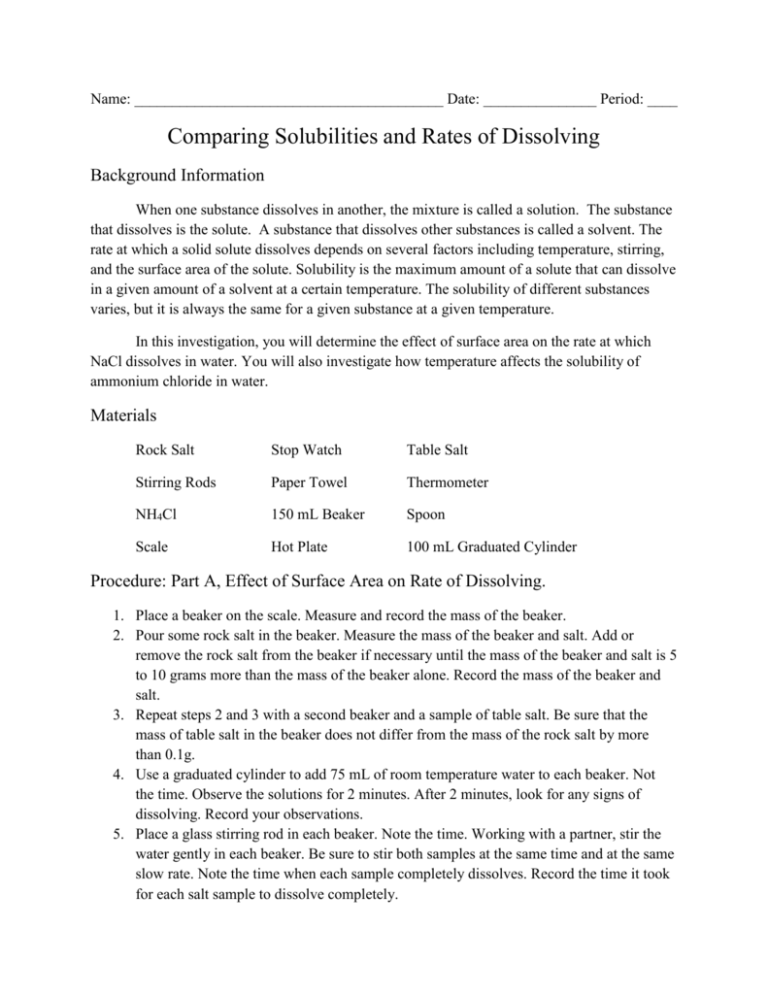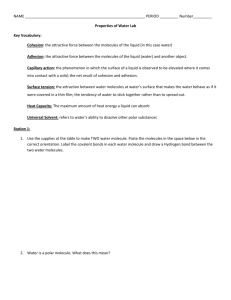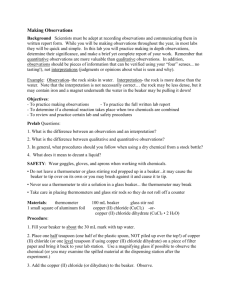Name: Date: Period: ____ Comparing Solubilities and Rates of
advertisement

Name: _________________________________________ Date: _______________ Period: ____ Comparing Solubilities and Rates of Dissolving Background Information When one substance dissolves in another, the mixture is called a solution. The substance that dissolves is the solute. A substance that dissolves other substances is called a solvent. The rate at which a solid solute dissolves depends on several factors including temperature, stirring, and the surface area of the solute. Solubility is the maximum amount of a solute that can dissolve in a given amount of a solvent at a certain temperature. The solubility of different substances varies, but it is always the same for a given substance at a given temperature. In this investigation, you will determine the effect of surface area on the rate at which NaCl dissolves in water. You will also investigate how temperature affects the solubility of ammonium chloride in water. Materials Rock Salt Stop Watch Table Salt Stirring Rods Paper Towel Thermometer NH4Cl 150 mL Beaker Spoon Scale Hot Plate 100 mL Graduated Cylinder Procedure: Part A, Effect of Surface Area on Rate of Dissolving. 1. Place a beaker on the scale. Measure and record the mass of the beaker. 2. Pour some rock salt in the beaker. Measure the mass of the beaker and salt. Add or remove the rock salt from the beaker if necessary until the mass of the beaker and salt is 5 to 10 grams more than the mass of the beaker alone. Record the mass of the beaker and salt. 3. Repeat steps 2 and 3 with a second beaker and a sample of table salt. Be sure that the mass of table salt in the beaker does not differ from the mass of the rock salt by more than 0.1g. 4. Use a graduated cylinder to add 75 mL of room temperature water to each beaker. Not the time. Observe the solutions for 2 minutes. After 2 minutes, look for any signs of dissolving. Record your observations. 5. Place a glass stirring rod in each beaker. Note the time. Working with a partner, stir the water gently in each beaker. Be sure to stir both samples at the same time and at the same slow rate. Note the time when each sample completely dissolves. Record the time it took for each salt sample to dissolve completely. Procedure: Part B, The Effect of Temperature on solubility. 1. Put 50mL of room temperature water into a clean beaker. Use a thermometer to measure the temperature of the water. Record this temperature in the data table. Remove the thermometer from the beaker. 2. Add on spoonful of ammonium chloride to the water in the beaker. Stir vigorously with a clean glass stirring rod until no more of the solid will dissolve. Make sure that you allow enough time for the solid to dissolve. 3. Repeat step 2 until no more ammonium chloride will dissolve. Note the number of spoonfuls of ammonium chloride that you added. Be sure to allow enough time for each spoonful of ammonium chloride to dissolve before adding more. Record the number of spoonfuls that dissolved in the data table. 4. Place the beaker of ammonium chloride solution on a hot plate. Place the thermometer in the beaker. Turn the hot plate to the medium low setting and warm the solution to 40C. 5. Remove the thermometer from the beaker. Add more spoonfuls of ammonium chloride to the beaker. Stir the solution and use the thermometer to check the temperature of the solution after you add each spoonful. Note the total number of spoonfuls of ammonium chloride that you added. Be sure to allow enough time for each spoonful of ammonium chloride to dissolve before adding more. Use the heat setting of the hot plate to keep the temperature constant as you add ammonium chloride to the beaker. 6. Record the total number of spoonfuls that have dissolved. 7. Turn up the hot plate to warm the solution to 60C. Then, repeat steps 11 and 12 with the solution at this temperature. 8. Turn up the hot plate to warm the solution to 80C. Repeat steps 11 and 12 with the solution at this temperature. 9. Record you data in the table. Type if NaCl Approximate Particle Size (Larger / Smaller) Mass of Beaker (g) Mass of Beaker and Salt (g) Appearance of Mixture After 2 Minutes Without Stirring Time to Dissolve (Seconds) Rock Salt Table Salt Temperature (C) 18 – 24 40 60 80 Number of Spoonfuls of Ammonium Chloride Dissolved Data Analysis 1. How did stirring affect the rate at which the salt dissolved? ___________________________________________________________________________ ___________________________________________________________________________ ___________________________________________________________________________ 2. Why did the different salts dissolved at different rates? ___________________________________________________________________________ ___________________________________________________________________________ ___________________________________________________________________________ 3. What is the manipulated variable in part A? In part B? _________________________________ ____________________________________ 4. In part B, why did the manipulated variable effect solubility? ___________________________________________________________________________ ___________________________________________________________________________ ___________________________________________________________________________




